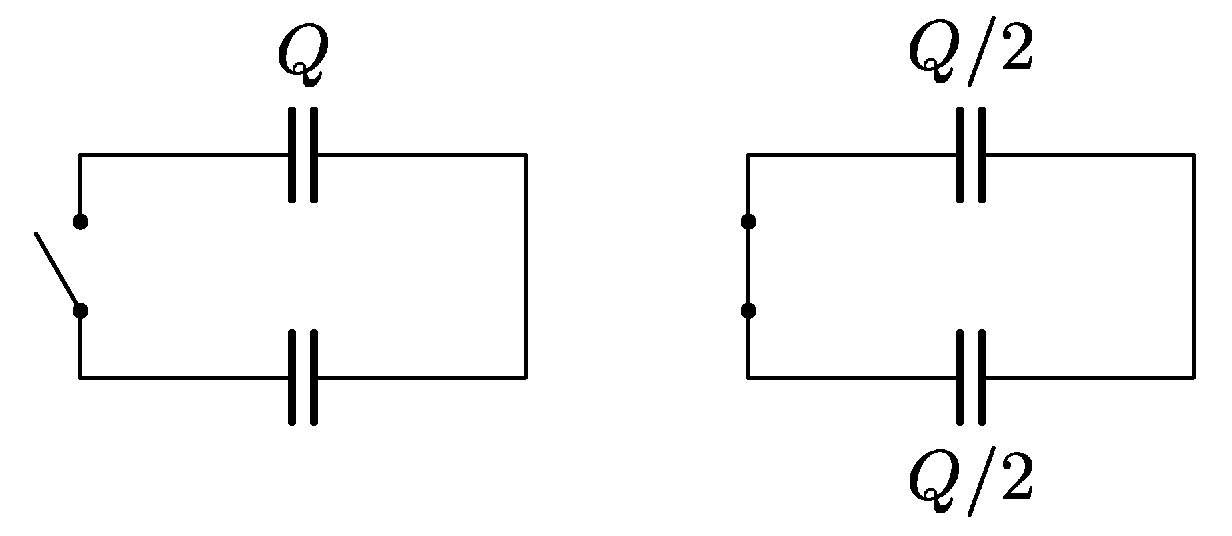Search
astrophysics (85)biophysics (18)chemistry (24)electric field (71)electric current (76)gravitational field (81)hydromechanics (146)nuclear physics (44)oscillations (57)quantum physics (31)magnetic field (43)mathematics (89)mechanics of a point mass (298)gas mechanics (87)mechanics of rigid bodies (221)molecular physics (72)geometrical optics (78)wave optics (65)other (167)relativistic physics (37)statistical physics (21)thermodynamics (155)wave mechanics (51)
electric current
(2 points)3. Series 29. Year - 2. alchemist's apprentice
The young alchemist George has learnt to measure electrochemical equivalents. He measured quite precisely the electrochemical equivalent $A=(6.74±0.01)\cdot 10^{-7}\;\mathrm{kg}\cdot C^{-1}$ of an unknown sample. How can he determine what substance was his sample made of?
(2 points)1. Series 29. Year - 1. densifying Hofmann
During the electrolysis in a Hofmann voltameter the electolyte is a soluton of sulfuric acid in water. The mass of the acid in the solution is practicaly constant but as the name says the water slowly dissolves into hydrogen and oxygen. So the concentration of the acid in the solution rises. How long will take for the mass fraction of the acid in the solution to rise to twice the original amount if there was a current of $I=1A$ passing through the solution, the original mass fraction of the acid in the solution was $w_{0}=5%$ and the volume of the solution in the container was$V_{0}=2l?$
Karel was thinking about electrolysis again.
(2 points)4. Series 28. Year - 1. square resistance
How does the eletric resistance of a square depend on the length of its side $a?$ All the squares that we are interested in are conductors made of a thin of a thickness $h$ and a resistivity $ρ$. We are interested in the resistance between the opposite sides of a square.
Karel was inspired at the fair of physics teacher's ideas.
(8 points)1. Series 28. Year - E. charged potato
Measure the load characteristic of a potato as a source of electric voltage with electrodes made from different metals.
Karel was thinking about easy experiments.
(4 points)5. Series 27. Year - 4. Trianglular resistor

Determine the resistance of a triangle created out of resistive wires between clamps A a B, that you see in the picture. One side of the small triangle (of which the bigger triangle is composed of) has the resistance of $R_{0}.Neglect$ the resistance of the wires that led it there.
Karel was drawing triangles
(4 points)2. Series 27. Year - P. Temelínská
Estimate how much nuclear fuel get used by an atomic powerplant to generate 1 MWh of electrical energy that people use at home. Compare it with the usage offuel in a thermal powerplant. Don't forget to think about all posible ways that energy gets lost.
Bonus: Include the energy that is required to transport the fuel into your solution.
Karel přemýšlel nad ČEZem.
(4 points)1. Series 26. Year - 3. geography for physicists
Imagine that there are wires along all lines of latitude and longitude. These wires are connected at each point where they cross. Given that the resistance of one meter of this wire is $ρ$, calculate the resistance of this network between the nodes located at the North and South pole. Assume that the angular distance of neighboring lines of latitude/longitude is 15$°$.
Bonus: What would be the resistance between two nodes located on the equator and opposite of each other?
Honza dreamed of an around the world trip.
4. Series 23. Year - P. Resistance
Do think of resistance of a flowing electrolyte. Is it dependent on the direction of the flow of the electric current? Try to evaluate the difference if there is any.
by hit Grepe
6. Series 22. Year - 1. resistance
Calculate the resistance of $n-dimensional$ cube between two most distant corners (with coordinates ( 0$,0,…,0)$ and ( 1$,1,…,1))$. The cube consists only from its edges (1-dimensional objects). Try to start with 3-dimensional cube and expand in higher dimensions.
Přednesl Lukáš Ledvina
4. Series 22. Year - P. save the physics

Disconnected electric circuit on the picture contains one uncharged and one charged capacitor (charge $Q)$. Wires are ideal with no resistance, both capacitors are identical. Total energy of electrical charges in circuit is then $Q⁄2C$. If the charges on capacitors become equal, then total energy will be $Q⁄8C+Q⁄8C=Q⁄4C$, which is half comparing to the beginning. Explain what happened and where the half of energy was used up. The switch is made in such way, that you can assume the energy loss has happened somewhere else.
S touhle záludností přišel Jarda Trnka.